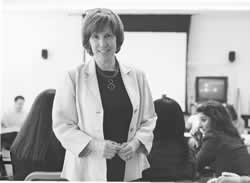A Campaign for Equity: Around the City
Spreading the Words
Lucy Calkins and TC's
They're a fixture at Teachers College: the hundreds of superintendents, principals and teachers who stream into Main Hall in the early mornings and then fan out to conference rooms, cups of coffee in hand. Their destination: Lucy Calkins and the Teachers College Reading and Writing Project.
Calkins-TC's Robinson Professor of English Education, and the author of classics such as The Art of Teaching Reading, The Art of Teaching Writing and Raising Lifelong Learners-has in all likelihood provided more professional development to educators than anyone else working in America today. Her organization works with schools and school districts in over 40 cities nationwide.
Calkins' approach falls into the camp known as "balanced literacy"-reading for meaning, using real texts rather than artificial ones, providing young writers with a simpler version of the workshop experience adults might encounter in an MFA program. Yet she brings to it a fervor uniquely her own.
"When you teach people to read or write, it's a profound relationship," she says. "You get close and it gives the work its heart. Especially with very young writers-you just pull up a chair and listen as they teach you about their lives." With reading, Calkins says, the trick is "to hook into beautiful literature that takes your breath away."
If that sounds somewhat open-ended, it's because Calkins absorbs as much from her clients as they do from her.
"Lucy
uses this phrase in one of her books-‘Welcome, trouble'-and that's
truly how she works," says Cathy Torres, co-coordinator for the Centers
for Learning in
As one of the major providers of literacy professional development for much of the
"Our aim isn't to put a doughnut shop on every corner," Calkins says. "We simply want to support literacy reform on a large scale. We think we're changing the world."
For Calkins, the key to achieving that goal is teaching good literacy skills through a workshop approach. "What makes for workshop teaching?" she asked a breakout group of principals and superintendents who had gathered one morning last fall to absorb her ideas about teaching fifth-grade social studies. "I'm not a social studies expert, but in any subject, the teacher must launch work that kids are invested in, and on which they keep working over time. And the teacher must explicitly teach skills that students accumulate and continue to draw on."
Take geography and the teaching of strategies that skilled map readers use. "Start with an analogy to reading," Calkins said. "When reading a book, you don't just dive into the main text, but instead you look first at the title and the table of contents. Just as, with a map, you start with its compass, its legend, its key."
Of course, soon you'll need to teach kids that different kinds of maps demand different skills, just as, say, a mystery requires the reader to look for clues while a novel may require more reflection on one's own experiences. Once kids possess that kind of repertoire, they can combine knowledge of a place from maps, photographs, charts and graphs. Then they can develop theories about their observations and defend them with supporting evidence. "It's always about bringing higher-level skills to the same work," Calkins said.
Later, striding back and forth across the stage of TC's Milbank Chapel with microphone in hand, Calkins urged all of the morning's attendees to think about creating a similar culture of learning among their faculty. She exhorted them to establish a community of practice in which teachers meet across grade levels to jointly plan curricula in all areas. And she told them how her own work has been shaped over the years by "dissonant voices that ask hard questions."
"If we listen to the people who cause us trouble," she said, "we'll find they have much to teach us."
Published Friday, May. 27, 2005
